Tips to Get better Results in WordPress Site Health
This article will show you how to get a good score in WordPress site health check and will also provide answers for frequently asked questions about the Site Health feature.
- What is WordPress Site Health Tool?
- How does it work?
- How to Check Website Health with Site Health Tool?
- How can a good site health score help your WordPress site?
- Tips to Get better results in WordPress Site Health Check Score
- FAQs
What is WordPress Site Health Tool?
WordPress introduced a site health check feature in version 5.1, which was relaunched with improvements in WordPress 5.2 to include a site health check score.
This feature helps website owners keep an eye on the performance and security issues that may affect their site and gives instructions on how to improve them. From outdated version checks to inactive plugin checks, the site health tool made a lot of tedious maintenance tasks a lot easier.
How does it work?
There are various steps that the Site Health tool automatically performs on your website; it runs a series of tests to see if your website is performing with optimal settings and summarizes all passed and failed tests. It then detects and provides you with what measures you should take to address or correct them. WordPress site health tool shows warnings, recommendations, and passed tests by explaining what they are doing to your site.
How to check Website Health with Site Health Tool?
Checking your website’s health is now super easy from the wp-admin panel. You just need to go to WP Admin > Tools > Site Health. You will see the overall site health status in a circle progress bar. The tool checks your website health and shows the result in the following categories.
You just have to switch between the tabs to see the status and get the information.
Site Health Status
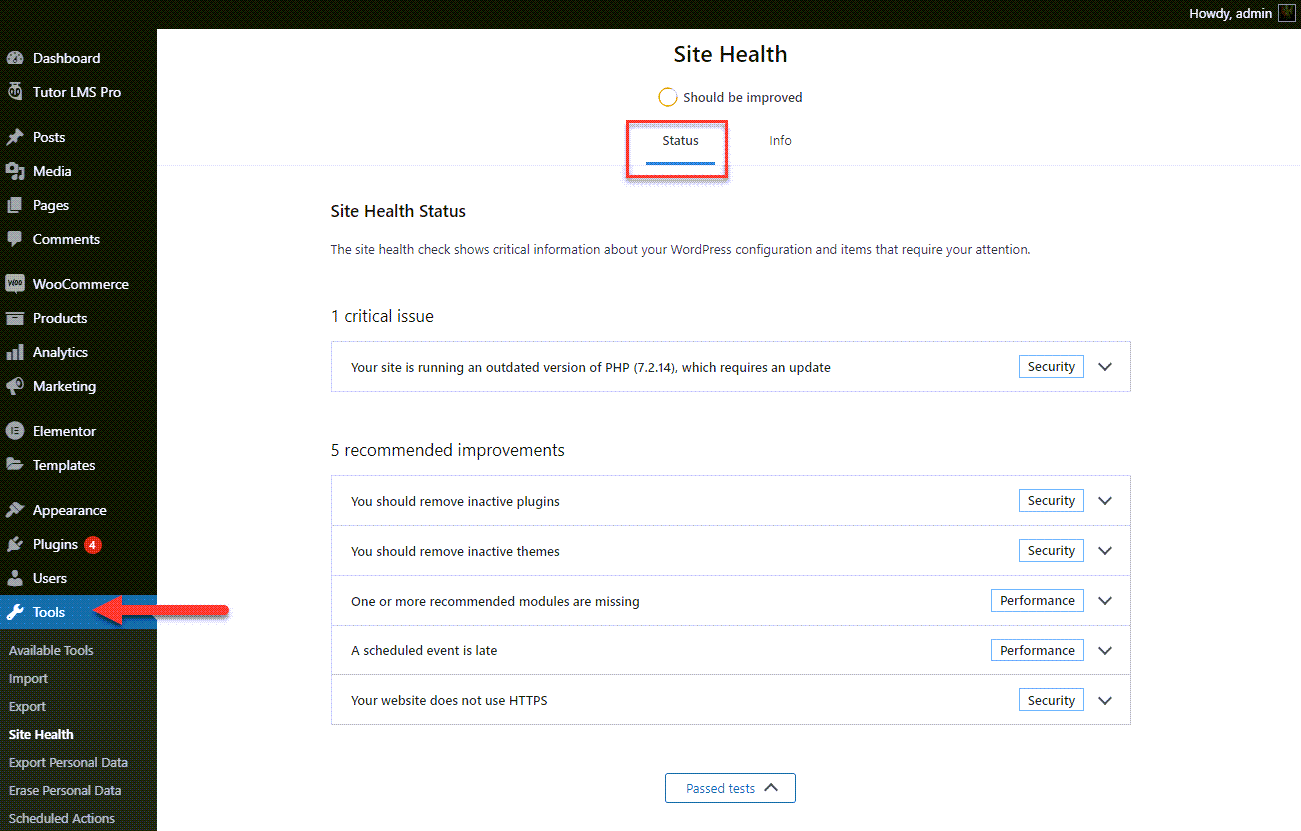
The Site Health Status shows critical information about your WordPress configuration and items that require your attention. If there’s anything that requires improvements shown on the Site Health Status page, The Site Health tool checks the issues in 2 major categories.
| Two Major Categories | |
| Performance | WordPress & PHP version, SQL server, required and recommended PHP modules are installed, UTF8MB4 support, scheduled events, HTTP requests, REST API, and loopback requests. |
| Security | Active themes and plugins, HTTPs connection, secure communication, debug mode off, communication with WordPress.org, and background updates status. |
The tool gives you site health status in 3 different layers:
| Site Health Status in 3 Different Layers | |
| Critical Issues | This shows the number of critical issues found. Marks issues with categories, namely, security or performance, and then indicate what to do about them. |
| Recommended improvements | Shows all the recommendations to improve site health and gives instructions on how to address them individually. |
| Passed Tests | Displays the number of items with no issues and shows all items in detail. |
Site Health Info
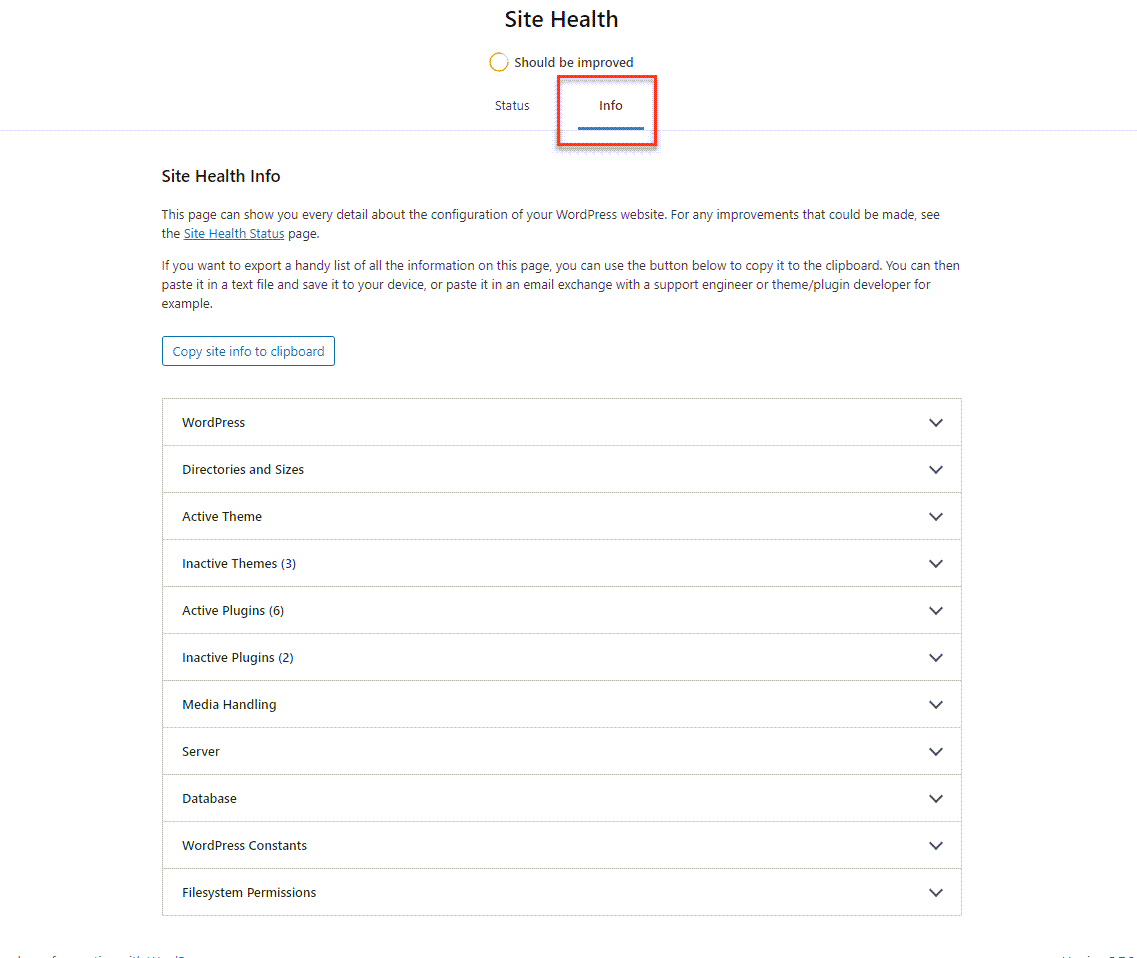
The Site Health Info page can show you every detail about the configuration of your WordPress website. After going to Dashboard > Tools > Site Health, it is just the page next to Status.
WordPress site health tool shows the information on different issues. The details below are the display of the issues in their respective categories.
| Display of the Issues in their Respective Categories. | ||
| WordPress | Version, site & user language, home URL, site URL, permalink structure, multisite check, and more | |
| Directories and Sizes | Directory location, size, upload location and size, theme location & size, plugin location & size, and more. | |
| Active Theme | Theme name, version, author, author website, parent theme, theme features, theme directory location. | |
| Active Plugins | Names of all active plugins, versions, and author names. | |
| Media Handling | Name of active editor, ImageMagick version number, string, resource limits, GD version, Ghostscript version | |
| Server | Server architecture, web server, PHP version, time limit, memory limit, max input time, upload max filesize, post max size, Imagick library status, .htaccess rules, and more. | |
| Database | Extension, server version, client version, database user, host, name, and prefix. | |
| WordPress Constants | ABSPATH, WP_HOME, WP_SITEURL, WP_CONTENT_DIR, WP_PLUGIN_DIR, WP_MAX_MEMORY_LIMIT, WP_DEBUG, WP_DEBUG_DISPLAY, WP_DEBUG_LOG, SCRIPT_DEBUG, WP_CACHE, and more | |
| Filesystem Permissions | This shows whether WordPress is able to write to the directories; it needs access to the main WordPress directory, wp-content directory, uploads directory, plugins directory, and a themes directory. | |
If you want to export the list of all the information on this page, you can use the button (Copy site info to clipboard) to copy it to the clipboard, then paste it into a text file and save it to your hard drive, or paste it in an email exchange with a support engineer or theme/plugin developer for example.
WordPress site health tool comes with 2 new pages to help you debug common configuration issues. It also adds space where developers can include debugging information for site maintainers. Scoring high on this tool means your site is in good health. The new Site Health Status information will educate users on the best security and performance practices.
How can a good site health score help your WordPress site?

Site health feature runs a series of tests to look for common performance and security issues on a WordPress website.
One example is a test that checks if your website is running the latest PHP version. Using older PHP versions can make your website slow and/or misbehave with many popular WordPress plugins. Getting a better site health check score ensures that your website is running under its best possible condition.
Tips to Get better results in WordPress Site Health Check Score
- Get a Reliable WordPress Hosting - Nothing impacts a website’s performance more than the web hosting service. This is the most important decision you make for a website. Unreliable hosting providers can affect your WordPress site in several ways. They tend to use older software, do not have all the PHP modules installed, and there is no easy way for users to fix those issues. Choosing a WordPress hosting company with a proven track record provides you with a solid platform to build your website. Good thing, Bluehost is an official WordPress partner.
- Install SSL / HTTPS in WordPress - SSL protects your website by encrypting the data transfer from server to user’s browsers. SSL-enabled websites use HTTPs instead of HTTP in their URLs and have a padlock icon in the address bar. SSL Enabled website - To switch from HTTP to HTTPs, you will need to install an SSL certificate on your website. Bluehost offers a free Let’s Encrypt SSL certificate that you can use for this.

For more details, please see: How To Activate Free SSL Certificate - Free WordPress SSL Setup.
- Keep WordPress Up to Date - WordPress is a regularly maintained open-source software. Each new WordPress release brings new features, bug fixes and improves the security of your website.
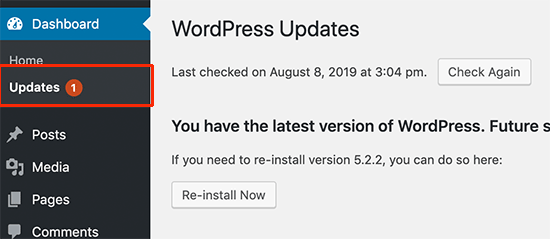
-
Many beginners fear that updating WordPress could break their website. They ignore WordPress updates and, as a result, leave their websites vulnerable to security threats. You need to make sure that you are always using the latest WordPress version
- Keep WordPress Plugins and Theme Updated - Just like WordPress itself, WordPress themes and plugins are also regularly updated. You need to keep an eye out for the available updates and install them to keep your site updated.

Plugins and themes use updates to deliver new features, fix bugs, and close security issues. You need to install updates to make sure that your website is not vulnerable to any known security issue.
For WordPress themes, you can simply go to the Appearance » Themes page to install an update. You can also update a WordPress theme manually. - Use The Latest MySQL Version - WordPress stores all your website content in a database. By default, Bluehost supports MySQL as a database management software for WordPress.
Using the latest version of MySQL ensures that WordPress can safely store your website data. An older version may cause your website to behave unexpectedly. You need to make sure that your website is running the latest stable version of MySQL. You can find the information about your database software version by switching to the info tab in site health. - Use The Latest PHP Version -WordPress is written in the PHP programming language. It is a server-side language, which means it runs on your hosting server to dynamically generate WordPress pages.
Using the latest PHP version gives your website a performance boost. It also ensures compatibility with new WordPress plugin features that may require the latest PHP version to work correctly.For more information, please see PHP Configuration.
- Keep WordPress Automatic Updates Enabled - WordPress comes with a built-in ability to update itself and install the latest security releases. These are minor releases but crucial for the safety and security of your website. However, site-owners do have the ability to turn off automatic WordPress updates. This can be done by using an update manager plugin or by adding code in the wp-config.php file. These security updates are automatically installed on millions of websites. Make sure that automatic updates are enabled on your WordPress site to keep your site secure with these timely updates.
- Remove Unused WordPress Plugins & Themes - Technically, you can use any number of WordPress plugins on your website as long as they are well-coded. It is recommended that you delete any inactive plugins that you don’t need. They take up space, can be used to hide malware, increase security scan time, and there is a chance you may accidentally activate them.
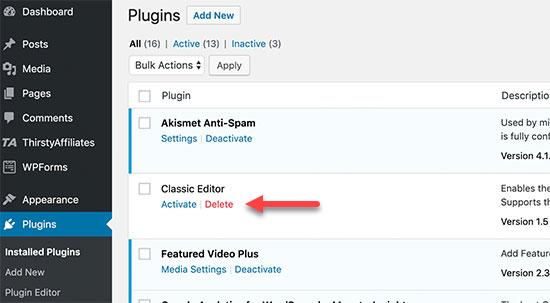
- Keep Rest API Enabled - REST API in WordPress allows developers to securely use HTTP requests to perform actions on a WordPress site. Many site owners disable REST API to protect their websites against brute force attacks. However, site health does not recommend it because you may need REST API to use third-party apps or some WordPress plugins. Make sure that REST API is enabled to improve your WordPress site health score.
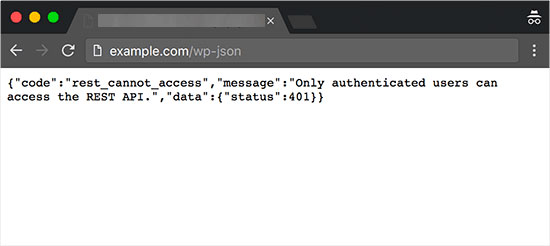
Note: We keep the REST API disabled on our sites to prevent brute-force attacks.
- Make Sure Required PHP Modules are Installed - PHP Modules and extensions are additional libraries that extend the functionality of the PHP programming language. WordPress recommends several PHP modules to be installed for optimal performance. You can find a list of extensions on the WordPress website. Some of these extensions are required, and others are recommended but not necessary.

Tip: How to install a missing module? - You will need to ask your hosting providers to install these extensions for you. Some web hosting providers allow you to install them from the hosting dashboard (look for PHP PEAR Packages). However, you would still need to configure them in php.ini file, which may not be easier for beginners.
- Disable WordPress Debug Mode - WordPress comes with a built-in debug mode that allows you to see if a plugin, theme, or custom code is throwing some errors. This feature is intended to be used by developers or advanced users. It is not recommended to turn on the WordPress debug mode for a live website. It may show warnings and notices in the WordPress admin area, which affect user experience.

- Make Sure WordPress Can Run Scheduled Jobs - Your WordPress website needs to perform scheduled tasks like checking for updates. These tasks use a system called cron jobs. Sometimes your hosting environment may block them from running, or you may accidentally end up stopping WordPress cron jobs. You need to make sure that WordPress can run these scheduled tasks to improve your site health score.
FAQs
Q: Do I need to get a 100% site health check score in WordPress?
A: No, you don’t need to get a 100% site health check score. Any score above 80% is considered good enough to run a WordPress website without significant issues.
However, it does feel great to get a 100% site health score. It also ensures that you are not missing out on any of the recommended WordPress suggestions for your website.
Q: Which site health checks are more important?
A: Site health tests are given three status labels:
- Good (Passed tests)
- Recommended (changes are recommended but not necessary)
- Critical (Significant issues that you must consider fixing)
- Critical issues are more important, and you should consider fixing them first.
Q: Does the perfect site health score means my WordPress website is secure?
A: No, the site health score indicates that your WordPress installation uses the recommended WordPress settings. You would still need to improve WordPress security to protect your website against common threats.
Q: How do I troubleshoot a WordPress site?
A: The site health feature also provides you with debugging information that can be used for troubleshooting. Simply switch to the info tab, and from here, you can find detailed information about your WordPress install.
If you need further assistance, feel free to contact us via Chat or Phone:
- Chat Support - While on our website, you should see a CHAT bubble in the bottom right-hand corner of the page. Click anywhere on the bubble to begin a chat session.
- Phone Support -
- US: 888-401-4678
- International: +1 801-765-9400
You may also refer to our Knowledge Base articles to help answer common questions and guide you through various setup, configuration, and troubleshooting steps.
